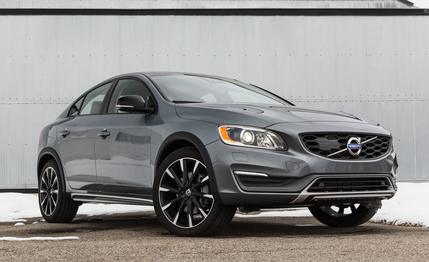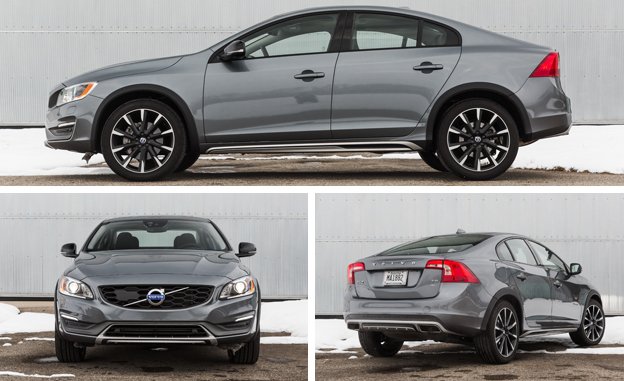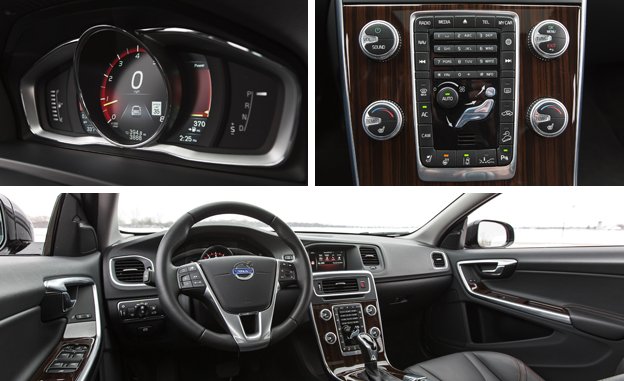
 Instrumented Test
Instrumented Test
Some ideas keep coming back. First, AMC put four-wheel-drive hardware under a Concord station wagon (née Hornet Sportabout) and dubbed it the Eagle—and then doubled down and pulled the same stunt with a sedan (and a coupe!). A decade later, Subaru tried the same thing and created the Legacy Outback wagon; and eventually it, too, thought What the heck, people are snapping up those Outback wagons, let’s try a sedan. Now Volvo is applying the formula for its thematically similar V60 Cross Country to the be-trunked S60.
The result is this S60 T5 Cross Country, which follows the V60 Cross Country into the breach by one model year. And to be fair, there are far more illogical ideas in the auto market (BMW X4, we’re looking at you). Volvo isn’t trumpeting this one’s sales potential too loudly—a spokesman told us there’d be “maybe 500” for North America this year. Given the tiny projected volume, Volvo builds ’em in a single trim level, the fancy Platinum, so the starting price for the sedan is higher than that of the V60 Cross Country, which comes with fewer technology features.


The Cross Country is otherwise the familiar S60 dressed up for bushwhacking, with all-wheel drive, hill-descent control, black fender extensions, “skid plates” front and rear, and a suspension raised to provide 7.9 inches of ground clearance. That figure is 0.8-inch less than what Jeep touts for the Renegade Trailhawk and Subaru for the Forester. Volvo, though, does have an advantage over Audi’s A4-based Allroad, which can only straddle 7.1-inch obstacles.
As in other all-wheel-drive S60s, putting traction to all four wheels means getting the soon-to-be-retired 2.5-liter turbocharged five-cylinder connected to a six-speed automatic. (Front-drive models get a more modern 2.0-liter turbo four and an eight-speed automatic—but a front-drive Cross Country would make even less sense, and Volvo doesn’t offer one.) The inline-five cranks out 250 horsepower and 266 lb-ft of torque, advantages of 10 ponies and 8 lb-ft over the direct-injected four. Every little bit helps, because this test car weighed in at 3817 pounds. That’s a rare finding in that our scales measured fewer pounds than the manufacturer’s claimed curb weight of 3913. It’s also 19 pounds more than the last S60 we tested—the front-drive, long-wheelbase Inscription—but 69 pounds below the S60 Polestar with AWD and a 345-hp turbo six.
Few drivers are likely to need the extra ground clearance, but as with the Outback and the Allroad the real aim of the off-road treatment is to raise the seat up, easing entry and exit and giving the driver the raised point of view that consumers in clinics keep telling car companies they like in crossovers and SUVs. They also keep telling those clinicians that roomy hatchback cargo areas are desirable, but that’s not what you get with this sedan’s relatively modest 12-cubic-foot trunk.
At the track, the Cross Country got to 60 mph in a crisp-enough 6.1 seconds, besting the turbo-four Inscription by a couple of tenths. It could manage only 0.86 g on the skidpad, though, whereas versions with the standard ride height have been in the 0.90-g range. Braking at 174 feet from 70 mph is on par for the S60 and midpack for similarly sized luxury sedans.


The Cross Country is aimed more at exploring unpaved and rarely traveled canyon trails, not for carving apexes. In our hands, it never did anything that a standard-ride-height S60 couldn’t have done with more precision. But it wasn’t a penalty box by any means—even upsized wheels didn’t hurt the ride enough to make it painful, and the suspension tames the wallow and excess roll just as the driver begins to notice that they’re more evident than in the standard car. The five-cylinder isn’t loud, although its aural character may motivate drivers to explore the nuances of the Harman/Kardon audio system that comes standard on the Platinum trim level.
Platinum includes plenty of other features, including an extensive package of safety technologies. It’s not “all the toys,” though, as Volvo continues to offer its BLIS (Blind Spot Information System) at an extra cost of $925. It’s not just blind-spot warning but rear cross-traffic alert, front and rear park assist, and lane-departure mitigation. It just seems odd that it costs extra when the standard kit includes adaptive cruise control, forward-collision warning with full auto braking, a driver-drowsiness monitor, lane-departure warning, and automatic high-beam headlamps.
The test car also had a $1550 Climate package (heating for the front and rear seats plus the steering wheel, along with the windshield and the washer nozzles, plus a special cabin-air filtration system), speed sensitive steering ($325), Urbane Wood Inlays ($400), and 19-inch matte-black wheels ($750). All in, it’s $48,390, a couple grand cheaper than the better-performing V60 T6. And, hey, it’s taller.